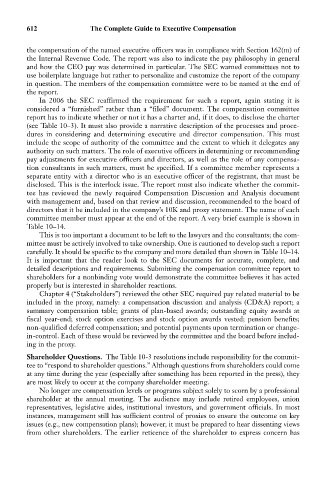Page 627 - Bruce Ellig - The Complete Guide to Executive Compensation (2007)
P. 627
612 The Complete Guide to Executive Compensation
the compensation of the named executive officers was in compliance with Section 162(m) of
the Internal Revenue Code. The report was also to indicate the pay philosophy in general
and how the CEO pay was determined in particular. The SEC warned committees not to
use boilerplate language but rather to personalize and customize the report of the company
in question. The members of the compensation committee were to be named at the end of
the report.
In 2006 the SEC reaffirmed the requirement for such a report, again stating it is
considered a “furnished” rather than a “filed” document. The compensation committee
report has to indicate whether or not it has a charter and, if it does, to disclose the charter
(see Table 10–3). It must also provide a narrative description of the processes and proce-
dures in considering and determining executive and director compensation. This must
include the scope of authority of the committee and the extent to which it delegates any
authority on such matters. The role of executive officers in determining or recommending
pay adjustments for executive officers and directors, as well as the role of any compensa-
tion consultants in such matters, must be specified. If a committee member represents a
separate entity with a director who is an executive officer of the registrant, that must be
disclosed. This is the interlock issue. The report must also indicate whether the commit-
tee has reviewed the newly required Compensation Discussion and Analysis document
with management and, based on that review and discussion, recommended to the board of
directors that it be included in the company’s 10K and proxy statement. The name of each
committee member must appear at the end of the report. A very brief example is shown in
Table 10–14.
This is too important a document to be left to the lawyers and the consultants; the com-
mittee must be actively involved to take ownership. One is cautioned to develop such a report
carefully. It should be specific to the company and more detailed than shown in Table 10–14.
It is important that the reader look to the SEC documents for accurate, complete, and
detailed descriptions and requirements. Submitting the compensation committee report to
shareholders for a nonbinding vote would demonstrate the committee believes it has acted
properly but is interested in shareholder reactions.
Chapter 4 (“Stakeholders”) reviewed the other SEC required pay related material to be
included in the proxy, namely: a compensation discussion and analysis (CD&A) report; a
summary compensation table; grants of plan-based awards; outstanding equity awards at
fiscal year-end; stock option exercises and stock option awards vested; pension benefits;
non-qualified deferred compensation; and potential payments upon termination or change-
in-control. Each of these would be reviewed by the committee and the board before includ-
ing in the proxy.
Shareholder Questions. The Table 10-3 resolutions include responsibility for the commit-
tee to “respond to shareholder questions.” Although questions from shareholders could come
at any time during the year (especially after something has been reported in the press), they
are most likely to occur at the company shareholder meeting.
No longer are compensation levels or programs subject solely to scorn by a professional
shareholder at the annual meeting. The audience may include retired employees, union
representatives, legislative aides, institutional investors, and government officials. In most
instances, management still has sufficient control of proxies to ensure the outcome on key
issues (e.g., new compensation plans); however, it must be prepared to hear dissenting views
from other shareholders. The earlier reticence of the shareholder to express concern has

